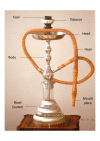The prevalence of waterpipe tobacco smoking among the general and specific populations: a systematic review
- PMID: 21504559
- PMCID: PMC3100253
- DOI: 10.1186/1471-2458-11-244
The prevalence of waterpipe tobacco smoking among the general and specific populations: a systematic review
Abstract
Background: The objective of this study was to systematically review the medical literature for the prevalence of waterpipe tobacco use among the general and specific populations.
Methods: We electronically searched MEDLINE, EMBASE, and the ISI the Web of Science. We selected studies using a two-stage duplicate and independent screening process. We included cohort studies and cross sectional studies assessing the prevalence of use of waterpipe in either the general population or a specific population of interest. Two reviewers used a standardized and pilot tested form to collect data from each eligible study using a duplicate and independent screening process. We stratified the data analysis by country and by age group. The study was not restricted to a specific context.
Results: Of a total of 38 studies, only 4 were national surveys; the rest assessed specific populations. The highest prevalence of current waterpipe smoking was among school students across countries: the United States, especially among Arab Americans (12%-15%) the Arabic Gulf region (9%-16%), Estonia (21%), and Lebanon (25%). Similarly, the prevalence of current waterpipe smoking among university students was high in the Arabic Gulf region (6%), the United Kingdom (8%), the United States (10%), Syria (15%), Lebanon (28%), and Pakistan (33%). The prevalence of current waterpipe smoking among adults was the following: Pakistan (6%), Arabic Gulf region (4%-12%), Australia (11% in Arab speaking adults), Syria (9%-12%), and Lebanon (15%). Group waterpipe smoking was high in Lebanon (5%), and Egypt (11%-15%). In Lebanon, 5%-6% pregnant women reported smoking waterpipe during pregnancy. The studies were all cross-sectional and varied by how they reported waterpipe smoking.
Conclusion: While very few national surveys have been conducted, the prevalence of waterpipe smoking appears to be alarmingly high among school students and university students in Middle Eastern countries and among groups of Middle Eastern descent in Western countries.
Figures
References
-
- Chaouachi K. The medical consequences of narghile (hookah, shisha) use in the world. Revue d Epidemiologie et de Sante Publique. 2007;55:165–170. - PubMed
-
- An Emerging Deadly Trend: Waterpipe Tobacco Use. American Lung Association; 2007.
-
- Akl EA, Gaddam S, Gunukula SK, Honeine R, Abou Jaoude P, Irani J. The effects of waterpipe tobacco smoking on health outcomes: a systematic review. International Journal of Epidemiology. 2010. in press . - PubMed
Publication types
MeSH terms
Substances
LinkOut - more resources
Full Text Sources
Medical
Molecular Biology Databases






